Mosaics in Rome: where to see the most beautiful ancient Roman mosaics and later mosaics in Rome + tips for your visit. Updated December 2021.
Roman mosaics are one of the most elegant art forms from the ancient world we can still enjoy today.
They can be seen in many locations in Rome city, both in churches and non-religious environments, and they bear witness to the development of taste and styles over the course of the centuries.
The most ancient mosaics from the Roman world date back to the III century BC but there are many examples of mosaics in Rome from Imperial times, the early Middle Ages and even the XIII-XIV century.
In this article, you will find the most important churches, sights and museums where to see the best mosaics in Rome and the info you need to plan a visit.
Beautiful mosaics in Rome worth seeing
The Roman Mosaics of Ostia Antica
One of the best places to admire ancient Roman mosaics in Rome is the archaeological park of Ostia Antica.
Located outside of Rome city center, Ostia Antica used to be the port city of ancient Rome and is now an important archaeological site so well preserved it is often compared to Pompeii.
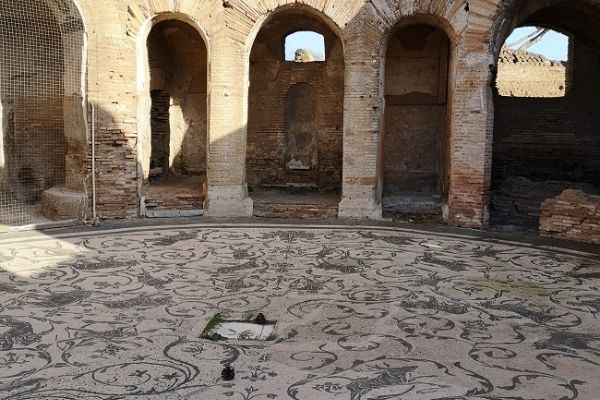
Among the many parts of the ancient city that survived until today, there are some stunning mosaics that date back to the II century.
These are mostly pavement mosaics, in white and black designs, and they have gotten to us in a remarkably well-preserved state.
Worth seeing are those at Baths of Neptune, (Marine theme), those from Piazzale delle Coprorazioni (trade theme) and those in the area of porta marina
In Ostia Antica, the mosaics are outdoors. This is a wonderful place to appreciate how elaborate yet also functional and sturdy these delicate-looking masterpeices truly are.
- Address: parco archeologico di Ostia Antica, Rome.
- Need to know: the mosaics are inside the archaeological park. Walking shoes/runners recommended for the uneven terrain of the park.
- You can read our guide to visiting Ostia Antica
Mosaics in Rome Baths of Caracalla
Wonderful examples of Roman mosaics can also be admired in Caracalla’s bath, the imposing ruins of the thermal bath created by emperor Antonino in the III century AD.
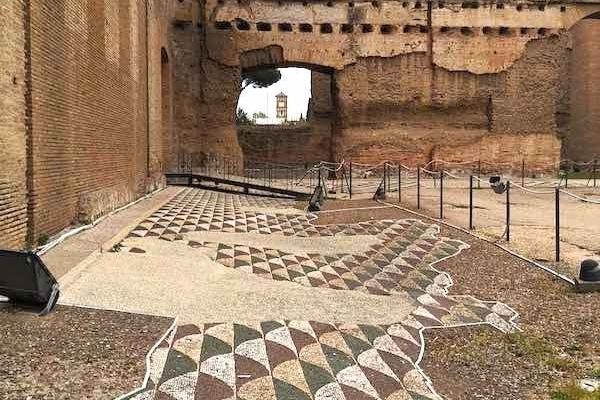
The mosaics here are similarly as those in Ostia antica, ground mosaics and they are nowadays outdoors.
In line with the use of the complex, that would have been a pace for thermal baths, sports and socializing, the mosaics represent sports and athletic scenes, mythological figures and also geometric patterns, some in black and white tones and some in several colors, especially yellow, red and dark green.
- Address: Baths of Caracalla, Viale delle Terme di Caracalla, 00153 Roma RM, Italy
- How to visit: Find tickets here. Walking shoes recommended
- You can find our full guide to visiting Caracalla’s Baths here.
Centrale Montemartini
Another wonderful place to see mosaics in Rome in Centrale Montemartini museum.
Centrale Montemartini is one of the most unique museums in Rome due to its special location and set up: priceless ancient Roman art is displayed in what used to be a power plant!
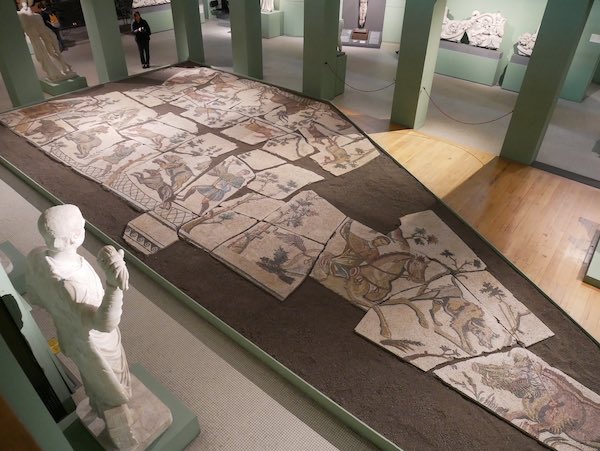
Part of the museum is devoted to Roman mosaics and the ones you have here are among the most beautiful in the city and date as far back as the I century BC.
Unlike those in Ostia Antica, the mosaics in Centrale Montemartini are preserved away from their original location yet they are displayed in such as way that it possible to appreciate from up close their making and beauty.
The colors, date, and type of scene depicted make these Roman mosaics unique in Rome.
Find here >>> my complete guide to visiting Centrale Montemartini, Rome
- Address: Via Ostiense, 106, 00154 Roma RM, Italy
- Get tickets here
The Roman Mosaics of Santa Costanza
Santa Costanza is a church dating back to the time of Emperor Constantine and it is home to beautiful ancient mosaics representing plants, vines and country scenes.
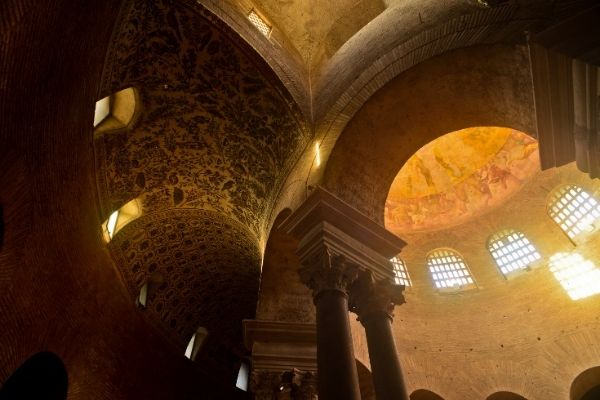
The church has very limited opening hours and it is accessible mostly during service time and it is one of the most peculiar in Rome thanks to its shape: Santa Costanza is a round church.
The mosaics were originally both on the ceiling and the walls of the church but only some of them are visible now. Those that are, however, are beautiful and unique in their natural theme.
- Address: Via Nomentana, 349, 00198 Roma RM, Italy
- Tickets: N/A
- Need to know: the mosaic is inside a church so suitable attire is required.
The mosaics of Rome Santa Prassede
One of the best places to see mosaics in Rome is the ancient and wonderful church of Santa Prassede.
Nestles in a small street in charming Rione Monti, Santa Prassede is home to the incredible Chapel of San Zeno, one of the very few examples of Byzantine style mosaics in Rome, more precisely in the style known to art historians ar ‘Carolingian Renaissance’.
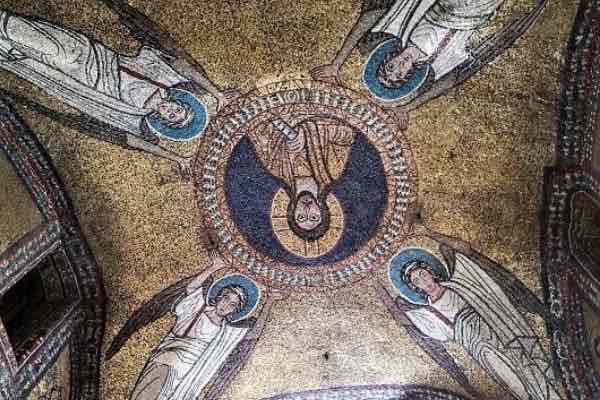
The chapel dates back to the IX century and has mosaics on on the walls and celing: they are made with mosaic tiles in gold, blue, white and red and dark green color and they represent the Christ Pantocrator, angels, several figures including Santa Prassede herself and scenes from the bible, inldiginf a famous depiction of the Garden of Eden.
- Address: Via di Santa Prassede, 9/a, 00184 Roma RM, Italy
- Tickets: N/A
- Need to know: the mosaic is inside a church so suitable attire is required.
- Find our guide to Santa Prassede here
The mosaics of Santa Pudenziana
Santa Pudenziana was the sister of Santa Prassede as has a church devoted to her that is a short walk away from that of Prassede herself.
As well as the location, the two churches have in common the fact of being home to invaluable mosaics, surprisingly different from each other.

Those in Santa Pudenziana are full of colors and symbols and art historians and religious authorities consider them a sort of theological synthesis representing scenes from the apocalypse, the Christ Pantocrator, and many scenes from the book of revelations.
What is peculiar about these Rome mosaics is that the Christian characters are represented in Roman style clothing, albeit reinterpreted in Christian key, something entirely unique.
- Address: Via Urbana, 160, 00184 Roma RM, Italy
- Ticket: N/A
- Need to know: the mosaic is inside a church so suitable attire is required.
The mosaics in Rome Santa Maria Maggiore
Santa maria Maggiore Santa Maria Maggiore is also home to beautiful mosaics, some the two sides of the main nave, dating back to the same time as the basilica itself (432-440AD) and some on the apse, subsequent.

Those on the nave develop over 27 frames and depict scenes from the Old Testament.
Originally there would have been over 40 of them but many god damaged and didn’t get to us.
Dating back to the same time are also the mosaics of the apse arch while those on the apse itself are by Torriti, who made them in the XIII-XIV century.
Santa Maria Maggiore also has an external mosaic, by Rusuti, from the XIV century.
The fact that the many mosaics in the church date back to different times makes it possible to appreciate how the taste, technique and iconography changed over time.
Find here >>> my complete guide to visiting the Basilica of Santa Maria Maggiore.
- Address: Piazza di Santa Maria Maggiore, Rome
- Ticket: N/A
- Need to know: the mosaic is inside a church so suitable attire is required.
Good to know: Santa Prassede, Santa Pudenziana and Santa Maggiore can easily be seen on the same day. You can follow our itinerary in the Monti neighborhood.
Mosaics in Rome’s San Clemente
San Clemente is one of the most peculiar churches in Rome as it has the peculiarity developing over 4 floors, each dating back to a different time.
The mosaics of San Clemente are in the church area and specific on the apse.
They are wonderfully intricate and very peculiar as they depict branches of acanthus bending into arabesques around an image of the Cross.
The mosaic is like no other in the city and has symbols that recall the classic (the spirals) and paleo-christian (the vines) iconography.
The exact date of these mosaics is under discussion but they are likely to be from the XIII century.
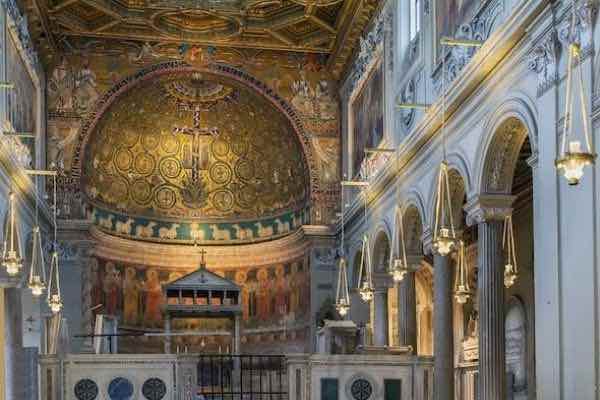
- Address: Via Labicana, 95, 00184 Roma RM, Italy
- Ticket: N/A
- Need to know: the mosaic is inside a church so suitable attire is required
The mosaics of Santa Maria in Trastevere
Other impressive mosaics are those we can now admire in the church of Santa Maria in Trastevere.
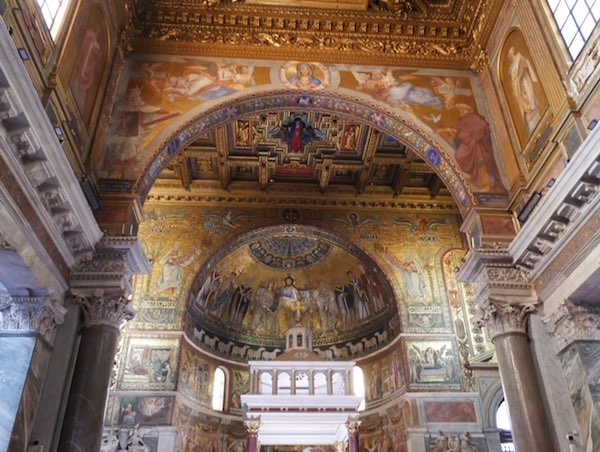
Here, the mosaic cover the apse and represent large reliogous figures against the a powerful golden backdrop.
The mosaic are among those that offer the strongest visual impact of those in the city however, they are also singifcinat from an art history point of view.
While the main mosaic is Byzantine in style, a second of the mosaics represents scenes from the life of the Virgin Mary dates back to the XIII century and the artist Cavallini.
The two mosaics one beside the other offer a unique opportunity to see how the taste and the influence of Byzantine art slowly evolved into what became the aesthetic of the Italian Renaissance.
- Address: Piazza di Santa Maria in Trastevere, Rome
- Ticket: N/A
- Need to know: the mosaic is inside a church so suitable attire is required
Interesting facts and additions info about mosaics in Rome
The art of making mosaic came to Rome from the East.
This ancient art is said to have been born in Mesopotamia and to have then arrived to Rome via contact with Greece and the Ellenistic world.
Greek were the first mosaic masters in Rome and the first examples of this art form in the city of Rome and it territories date back to the III century AD.
Mosaics are made of small tiles, called tesserae, arranged and then attached to a special support to keep them in place. The tesserae are obtained by carefully cutting stones of different colors that are also what give the mosaics their polychrome effect: mosaics were not painted but rather, each color is guaranteed by the use of a different type of stone.
Good to know! You can learn about mosaics and try your hand at making them in a wonderful mosaic artisan workshops in Rome that offers classes for adults and kids. Find our review here.
I hope you enjoyed this quick overview of where to see mosaics in Rome. Safe travel planning!
